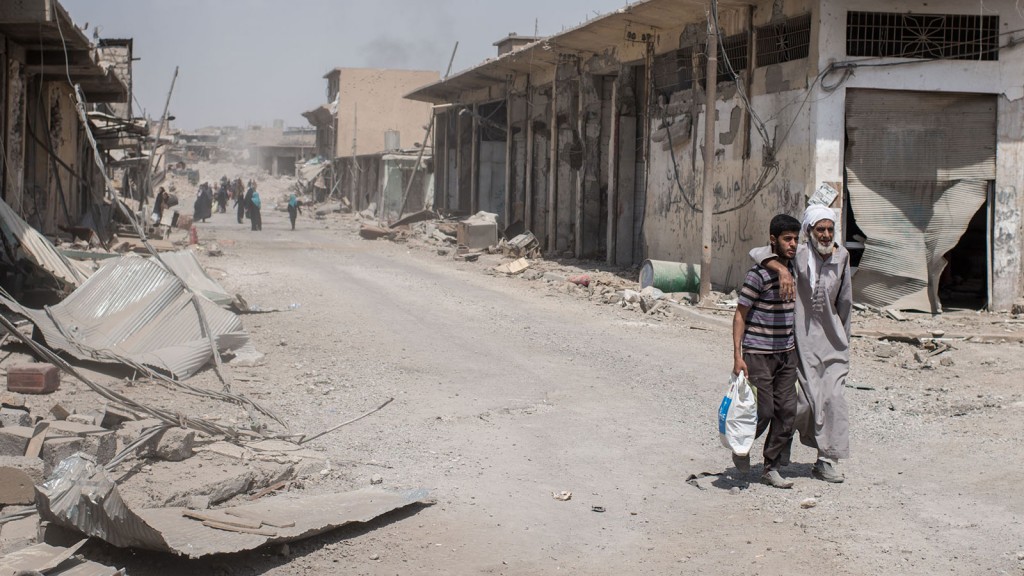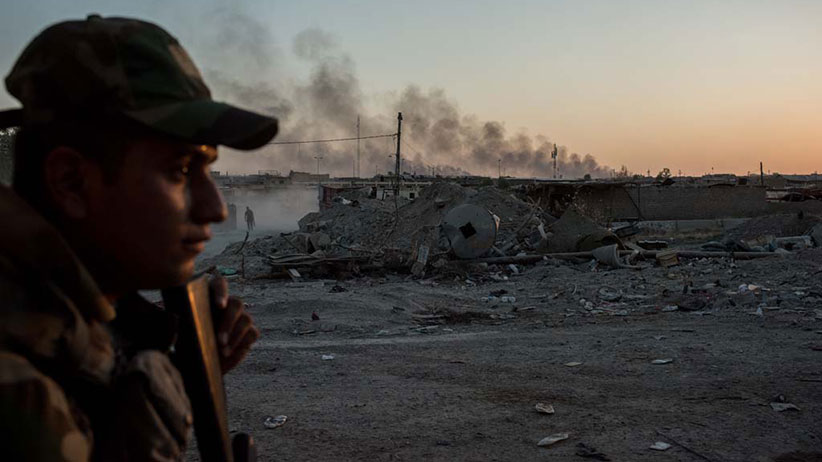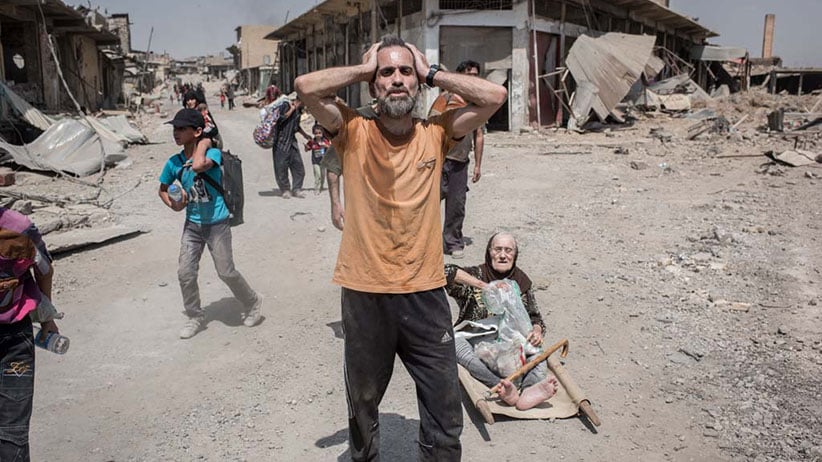The terrifying last days of ISIS in Mosul
Brutal fighting and mounting civilian casualties threaten a Pyrrhic victory for Iraqi Security Forces
A man helps an elderly man walk into Iraqi government controlled territory in Mosul, Iraq on June 20, 2017. (Photograph by Cengiz Yar)
Share

On the eve of the battle for Mosul’s Old City, Moaaz Sidawy was preparing to open a third operating theatre in the hospital he managed in west Mosul. A 37-year-old Syrian surgeon, Sidawy was concerned that an influx of civilians would overwhelm his facilities once Iraqi Security Forces began advancing into the densely populated Old City, where Islamic State diehards were making their last stand.
Mosul General Hospital had been torched by retreating Islamic State militants months earlier and while partially renovated it was operating at reduced capacity. On an average day, it might receive 100 patients but regular mass casualty events could see 100 cases arrive at once. In such times, the 35 staff on shift struggle to triage the most critical, while others lie on the floor.
“We expect the numbers will really increase once the battle for the Old City starts,” Sidawy said.
After eight months of fighting, Iraq is on the verge of dealing a death blow to the last Islamic State stronghold in Mosul. But in the battle’s final days, the brutal logic of total war is threatening to render the victory a hollow one. By now, Mosul has become a worst-case scenario that is more dire than anyone predicted.
READ MORE: Why the death of ISIS’s leader could spell trouble
To show what the coming days would bring, Sidawy descended the hospital’s soot-stained stairs to the wards. There a pregnant woman tended to two badly wounded girls. Bandages covered their bodily injuries but the older girl’s face was burned, while the toddler’s head was covered in blast wounds. Shaima El Abd Fethi, a worn looking 36-year-old, shooed the flies from her daughters’ sores while attempting to suppress her own grief.
After living under siege conditions in the Old City for months, she and her husband had finally decided to flee the week before, she said. Their children were ill from contaminated drinking water and terrified by the airstrikes. But the militants would not let them go. “We had heard stories that a fighter would say that families could leave, but there would be another fighter hidden further along who would shoot them,” Fethi said. “To make it look like the Iraqi Security Forces were killing civilians.”
In one three-day period in June, the UN documented 204 civilians killed trying to escape, mostly by ISIS snipers. By the logic of the militants, those who fled their caliphate were unbelievers, deserving of death. An estimated 100,000 civilians still living in the few square kilometres of the Old City were, effectively, hostages.
While their presence slowed the Iraqi advance, corralling the civilians fulfilled another, more sinister purpose. Faced with inevitable defeat, the militants were trying to sow future discord by maximizing the deaths by coalition bombs and crossfire.
Despite the risks, her husband Ismail Mohamed and some nearby relatives made an escape plan. One night after midnight, they walked through silent streets and into a field. “We didn’t know the way,” Fethi remembered. “We didn’t know it was booby trapped.”
Stumbling in the dark, one of her other daughters triggered an improvised explosive device. Iman, 13, and Bara, 7, were killed instantly; 11-year-old Tabarak was on fire. “Her hair was burning,” Fethi said. “When I put it out, she was lying there lifeless.”
Her husband was mortally wounded. “His leg was off,” she said. “He told me to go but I wouldn’t leave him.”
She passed her injured daughter Shahar and five-year-old son Usam to an uncle who continued on, while she stayed with her husband and the bodies of her daughters. “Wild dogs surrounded me but I threw stones at them to keep them at bay,” she said. “I am a person who is easily scared but that night I don’t know what overcame me.”
In the morning her husband was dead but Fethi realized that Tabarak was alive, though seriously wounded. Fethi tried to carry her daughter to safety but every time she stood up a sniper shot at her. “Finally, I decided that either God would protect me or he would not,” she said. “So I walked, ignoring the bullets.”
Making it to safety, she and her children joined the nearly 900,000 civilians to have fled their homes in Mosul. Last year the United Nations predicted that in a worst case scenario, 750,000 might flee. And in the coming days, thousands more families would make the same impossible calculus: risk starvation and airstrikes in their homes or face IEDs and snipers if they fled.

EARLIER THAT DAY, in a cratered street not far from the hospital, staff brigadier Shuker Radan Salim of the Iraqi Army 9th Division pored over his map. His men were 40 metres from the northern edge of the Old City but open ground lay in between and advancing was proving difficult.
“You need to take the school,” the stocky officer spoke into his radio.
“Ok but first we need airstrikes and artillery,” came a crackling reply.
Salim barked more orders, approving air support. Satisfied his men would reach their objective, he turned his mind to the Old City. While the rest of west Mosul is laid out in orderly grids, the Old City is a warren of densely packed old houses and winding alleyways. Much of the fighting would be on foot, with every step liable to trigger a hidden IED. Like many officers, Salim was preternaturally optimistic about how long it might take: “Maybe a week, maybe 10 days.”
It was never supposed to take this long, though, or be this tough.
When the operation began last October, military spokesmen predicted the fighting would be over within weeks. “Victory is near,” Lieut.-Gen. Abdel-Wahab al-Saadi of the Counter-Terrorism Service said at the time.
The plan then was for the elite Iraqi Special Operations Forces (ISOF) soldiers to push into the city from the softly defended east. The Tigris River divides Mosul and the right bank was considered more liberal, less beholden to ISIS ideology. It was hoped that a shock punch could knock the militants and their supporters out into the western desert towards the Syrian border.
That plan changed in November when Shia militias unilaterally moved west of the city to seal any escape route. When these militias linked up with Kurdish Peshmerga lines, the battle for Mosul became a siege.
The advance slowed as ISOF soldiers faced a campaign of suicide bombings carefully calibrated to extract a maximum cost for each neighbourhood ceded. By the time they declared victory in east Mosul in January, ISOF had sustained heavy losses. In fact, Iraq’s most competent fighting force had been nearly destroyed.
READ MORE: What went wrong in Mosul
Faced with unsustainable losses, the Iraqi government called in new units to carry out much of the fighting in west Mosul. These included poorly trained federal police and army units that relied much more heavily on airstrikes to advance.
The cost of these new tactics was reflected in rising civilian casualties and widespread destruction. In April and May, coalition aircraft launched approximately 6,800 airstrikes, rocket and artillery munitions, according to civilian casualty tracking group Airwars. In one strike, the coalition admitted it had killed up to 141 civilians after it dropped a 500-pound bomb on a house targeting two ISIS fighters.
On the street level, the destruction was striking; rubble-strewn roads, endless smashed walls, shattered windows and destroyed vehicles.
The heart of Mosul’s Old City has always been Al Nouri mosque. Its leaning minaret—Al Hadba—presided over the city for 800 years, and eventually adorned the Iraqi 10,000 dinar bill. ISIS head Abu Bakr al-Baghdadi proclaimed himself leader of Islamic State’s caliphate during Friday prayers at Al Nouri in July 2014. For the Iraqi government, retaking the mosque would provide a potent symbol of the destruction of the caliphate, and a much-needed propaganda coup.
The bullet-scarred ISOF veterans were considered the only unit up to the task and were called upon once more. The Iraqi Army 16th Division would support their northern flank, while federal police units advanced to the south. The offensive began promisingly, ISOF soldiers broke through ISIS defences to within 200 metres of the mosque within days.
On June 20, a blue-eyed ISOF soldier was watching television in a rear base in west Mosul. The news showed his comrades close to the mosque. Ahmed al-Jbouri would soon join them. While the mosque was significant for the politicians, to him it was just another objective. “It’s nothing, ISIS will blow it up before we get to it,” the 25-year-old predicted.
The past three years of fighting ISIS had gradually ground Jbouri into a resigned fatalism. Countless battles had cost him more friends than he cared to remember. “I don’t think about anything anymore,” he said. “I just want to finish this and see my kids.”
But he knew that even after Mosul, there would be more fighting. “When an Iraqi baby is born they should hand him a gun,” he said. “Because his whole life will be fighting. We don’t like fighting but we have to.”
Switching the channel to a Lebanese soap opera, he concluded: “We’ll keep fighting. I don’t even care anymore.”
The next morning ISIS blew up the mosque.

BY FRIDAY, JBOURI and his comrades were within 50 metres of the ruined minaret. But there was a problem. To the south the federal police hadn’t advanced, and to the north, the 16th Division was making slow progress. The ISOF soldiers were supposed to retake the mosque the next morning, but they were exposed.
While front lines were clear on the map, in the rubble of the Old City the situation was chaotic and confusing, with soldiers as busy helping fleeing civilians as they were fighting. Ahmed Abd, a young 16th Division soldier from Nasiriyah, explained the difficulties: “We’re pushing today but there are so many IEDs and so many civilians coming out.”
As the heat increased, straggling civilians staggered through the ruined streets. Bearing signs of malnutrition, skin disease, and blast injuries recent and old they wailed a litany of horrors, many hysterical and senseless from fear. Others were ecstatic to escape, ululating and cheering.
“Today we were dead!” cried a man carrying two women’s hand bags. Like others, Saif Fares Taha had pulled himself from the rubble of his bombed home and his hair was matted with dust.
“My city, it’s destroyed!” an elderly woman muttered endlessly.
“Give us food!” a mother cried as her small children fell upon styrofoam trays of uneaten soldiers’ rations.
Earlier that day a suicide bomber had detonated among the fleeing civilians, making the soldiers paranoid. When a grey-haired man came out without relatives or identification, they demanded he lift his gown to show he wasn’t wearing an explosive belt. The man revealed hidden wounds and the soldiers blindfolded him, then drove him away tied to the bumper of a Humvee.
The battle-hardened soldiers seemed shocked by the condition of the civilians, their reactions oscillating from anguished to accusatory.
“Get out of here, you’re all ISIS!” a wild-eyed soldier yelled, waving his pistol at a mother and her two small children. “When they smile at us it’s all fake,” he said afterwards. “They don’t deserve anything.”
As a charred baby was rushed to a medical clinic, another soldier seemed to question his faith. “What kind of f–king religion is this?” he cried.
Present throughout the chaos were small acts of compassion. “We’re here to serve you,” a soldier repeated, passing bottled water to the civilians. Another soldier washed the children’s faces.
That evening, the men of the ISOF Salahuddin Battalion relaxed in an abandoned house a few hundred metres from the front line. Sprays of bullets passed overhead but at this distance they sounded harmless, like flocks of cheeping birds.
“It’s been 23 days with no leave,” said Awoos Mahmoud Jassem, a gaunt sergeant with a drooping moustache. They were committed now to a final push to finish the battle, he said.
Outside a generator roared to life and a ceiling fan began to turn. The men plugged in their phones and called loved ones. Later, as they engaged in the carefree banter of men who knew they could die tomorrow, Jassem placed fresh packs of cigarettes in his comrades’ webbing pouches.
After dark, he took his blanket to the roof and lay down in his uniform. Parachute flares lit the Old City a jaundiced yellow, red tracers flickered across the rooftops and airstrikes flashed like lightning. Jassem’s radio crackled to life. New orders: the morning’s operation to retake the mosque was postponed.
For Jassem and his brothers-in-arms, the delay was a brief reprieve. For the civilians awaiting escape, it spelled another day of uncertainty.